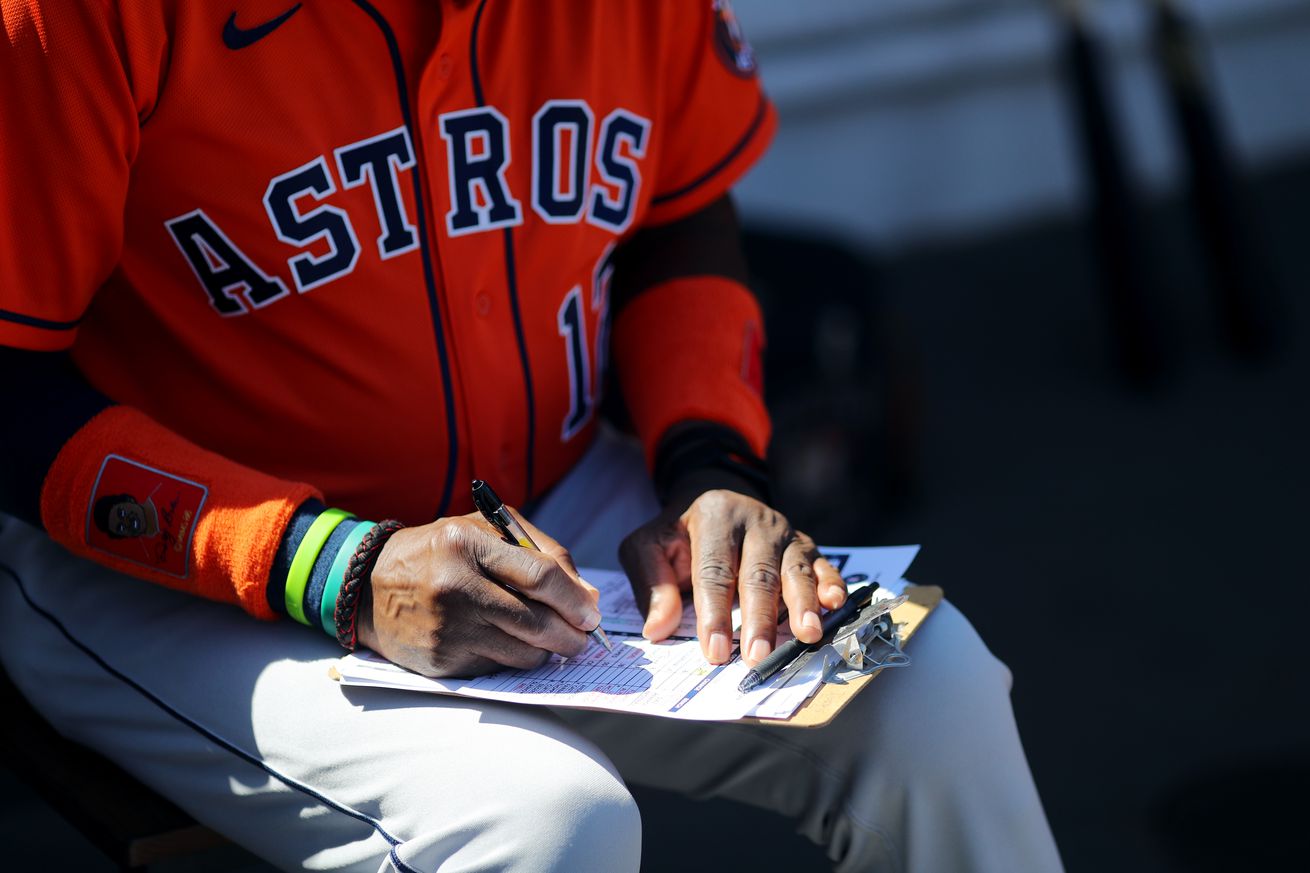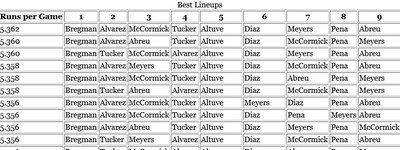
A New Manager and A New Batting Order. What is optimal? Does it matter?
Baseball fans like to talk about their team’s batting order. And everybody’s got an opinion. It’s also one of those subjects people like to talk about during spring training—when the manager might try out different lineup ideas. And since the Astros have a new manager this year, extra curiosity surrounds the subject.
Manager Joe Espada spurred a bit of news last week when he disclosed that he might put Yordan Alvarez at Number 2 in the batting order. He asked Alvarez if he would mind if he batted him at the 2 slot, and Alvarez said he doesn’t mind batting in another position if it helps the team. Last year, Alvarez never batted in the No. 2 position. He batted 98 games in the 3 slot and 15 games in either the 4 or 5 slot.
It’s natural for a new manager to have his own thoughts and preferences about batting order. Former manager Dusty Baker’s line-up decisions in 2023 were controversial among fans. I think some of the criticism was fair, but a lot of it was unjustified. But dealing with criticism is just part of the manager’s job. Given his background, I am hopeful that Espada’s decisions may be aligned more with sabermetric thinking. But in the end, no matter what lineups he draws up, I am sure there will be critics.
I usually view batting order debates as overwrought. In the modern era,a reasonable range of varied batting orders is likely to produce run scoring differences which will be small or even de minimus. This is particularly true when a “bad” batting order decision is used for only a few games. In a small sample, it’s almost impossible to predict if one batting order will produce more or less runs than another order.
I suspect that poorly designed batting orders were more inefficient and costly (in terms of runs scoring) 30 or 40 years ago. Many managers adhered to a series of fables about how batting orders should be constructed. For instance, weak hitting but speedy players frequently batted lead off. And the No. 2 slot was reserved for hitters who were viewed as bat handlers—mediocre or weak hitters who could bunt the runner over or direct a groundball in a direction that advances the runner. For example, Astros shortstop Roger Metzger batted lead off in 275 games and No. 2 in 300 games. When you consider that Metzger’s career OBP was .291 and his career OPS+ was 65—well, the batting order problem is obvious.
During the last ten years, batting orders have improved. Almost all teams realize that the better offensive players should bat in the upper part of the batting order. And the practical differences between optimal and slightly sub-optimal batting orders are minor. That said, the more noteworthy sub-optimal lineups can be grating on the aesthetic senses—even if the impact on winning or losing is minor.
So, let’s discuss optimal lineups for the 2024 Astros. As I did last year, I will use Baseball Musing’s Lineup Analysis Tool (developed by Morong, Arneson, and Armbrust). Although the model is dated, to my knowledge it is the best publicly available simulation model. After inputting starters’ OBP and SLG, the model’s algorithms utilize a large data base of games to simulate the manner in which lineups turn over.
For Astros batters’ OBP and SLG, I utilized the 2024 ZIPS projection. The lineup analysis model has a choice of using a larger or smaller data base of games, and I chose the larger data base (which has a lower run scoring environment) because it produces a result closer to the Fangraphs’ Runs/Game Astros Projection. The model churns out the 31 best lineups and a similar number of the worst lineups.
I have reproduced the top ten optimal lineups.

Baseball Musings Lineup Tool
You can click on the lineup tool link, above, to see all of thee best and worst lineups. According to the model, the average Astros’ lineup produces 5.2 runs per game—within shouting distance of the Fangraphs projected 5.1 runs per game. And keep in mind that the runs per game of this lineup, comprised of the main starters, is probably a best case scenario, since many lineups, by necessity, will include one or more back up players.
For my evaluation of the lineups, I occasionally will refer to “The Book: Playing the Percentages in Baseball” by Tango, Lichtman, and Dolphin (“The Book”), which develops a sabermetrics view of constructing batting orders. For additional explanation, you can read this Beyond the Boxscore article about developing lineups.
The Book concludes that the three best offensive players should be placed in the 1, 2, and 4 lineup positions. The two best hitters should occupy the No. 2 and No. 4 position, with the higher OBP hitter at No. 2. The No. 2 and 4 slots are equally important positions. As the BtB article states: “The Book says the #4 hitter comes to bat in the most important situations out of all nine spots, but is equal in importance to the #2 hole once you consider the #2 guy receives more plate appearances.”
According to the ZIPS projections, Yordan Alvarez is the Astros best hitter in both OBP and SLG. Alvarez’s .393 OBP fits well in the No. 2 slot, and he is the Astros’ best overall hitter. Kyle Tucker is the Astros’ second best hitter, according to ZIPS. Alvarez and Tucker could be interchangeable between the 2 and 4 slot, but Alvarez’s high OBP means that fewer outs will be made in a slot that receives the second most plate appearances.
According to the lineup tool, Alvarez is assigned the No. 2 slot in 7 of the 10 best lineups. Tucker is No. 2 in the remaining three lineups. The model produces an inverse result for the No. 4 slot in the 10 best lineups: Tucker at No. 4 seven times and Alvarez at No. 4 in the remaining three lineups.
Espada considering Alvarez at No. 2? This checks out as an optimal lineup decision. Score one for the manager.
Would Espada bat Alvarez and Tucker back to back, at No. 2 and 3? I don’t know. But lineup optimization would prefer Tucker at the No. 4 (clean up) slot. Alvarez batted mostly in the 3 slot last year. Although I don’t think it was a bad decision, the Book doesn’t favor putting one of the two best hitters at No. 3. Why? The No. 4 slot will see more runners on base than No. 3. And, as the BtB article explains: “Surprisingly, because he comes to bat so often with two outs and no runners on base, the #3 hitter isn’t nearly as important as we think.”
A sabermetric view is that the No. 3 slot can be reserved for an above average, but flawed, hitter (for instance, a power hitter who strikes out too much). The Top 10 lineups are consistent with that profile. Chas McCormick is at No. 3 in five of 10 cases, and Jose Abreu and Jake Meyers split the remaining cases at No. 3.
The No. 1 slot should be one of the team’s three best hitters, but whose forte is getting on base. The lineup optimizer overwhelmingly prefers Alex Bregman in that spot. And when you consider Bregman’s good batting eye and plate discipline, this makes sense. Bregman is lead off in all Best 10 lineups, and he is lead off in 29 of 31 best lineups. The only two cases without Bregman at lead off puts Altuve (last year’s No. 1 batter) at that position.
The Book views the No. 5 and 6 slots as secondary clean up spots. As the BtB article say about the No. 5 slot: “After positions #1, #2, and #4 are filled, put your next best hitter here, unless he lives and dies with the long ball.”
The Best 10 lineups all have Jose Altuve at No. 5, followed by Yainer Diaz at No. 6. I know we’re used to Altuve at lead off, but admittedly Altuve’s combination of batting average, extra base hits, and HRs makes sense as a “second clean up hitter.”
Let’s face it. Altuve will probably continue as lead off hitter. It’s one of the perks of his iconic status. So, let me show one of the two Top 31 lineups with Altuve leading off. Personally, I think it’s pretty good. One thru Nine: Altuve, Alvarez, McCormick, Tucker, Bregman, Diaz, Meyers, Pena, Abreu.
In the Top 10 best lineups, Jeremy Pena takes the 8 position in 9 of 10 cases. Generally, the 9 position is viewed as a second lead off position to turn the order over and provide a RBI opportunity for the 1 or 2 slot hitters. Abreu, Meyers, and McCormick are in this position in various Top 10 cases.
How Much Difference Does It Make?
This exercise confirms that the run scoring difference for the range of reasonable lineups is quite small. The best lineup is 2 runs scored per year better than the No. 31 best lineup. That doesn’t mean you should ignore better lineup choices. However, you shouldn’t worry about reasonable departures from “optimal.”
On the other hand, the difference between the optimal lineup and the worst lineup is quite costly. The best lineup is 67 runs better than the worst lineup—equivalent to 6 – 7 wins. The good news is that the worst lineup is unlikely to happen. Only if Espada takes leave of his senses would he bat Alvarez and Tucker at 8 and 9.
I haven’t addressed batting against LH and RH starting pitchers. It’s possible that different batting orders would be justified if a tough lefty or righty starting pitcher had strong platoon splits against particular Astros’ hitters. However, given that Alvarez and Tucker are less affected by platoon splits, I’m not sure it would lead to a much different optimal lineup.